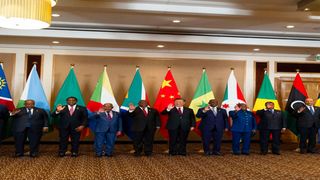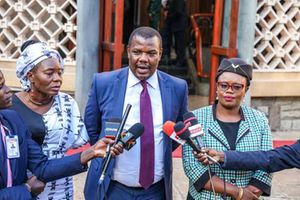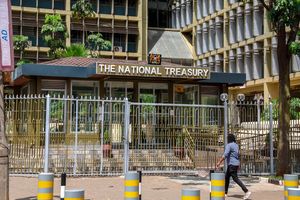
From 2nd L to R: Presidents Hage Geingob (Namibia), Hakainde Hichelema (Zambia), Azali Asoumani (Comoros and Chairperson of the African Union), Cyril Ramaphosa (South Africa), Xi Jinping (China), Macky Sall (Senegal), Evariste Ndayishimiye (Burundi) and Denis Sassou Nguesso (Republic of Congo) during the China-Africa Leaders' Roundtable Dialogue on the final day of the BRICS Summit 2023 in Johannesburg on 24 August 24.
| Alet Pretorius | AFPWeekly Review
Premium
How Brics could change the playground in international trade
What you need to know:
- The Brics was formally established among Brazil, Russia, India, and China in 2009, in the aftershocks of the global financial crisis.
- Relating to currency displacement, the British pound sterling once was a hegemonic currency though humbled today.
The rest of the world could have unwittingly paid to the US government for decades a tax called seigniorage.
The dollar in a game of dice: This article discusses the state of Brics following their 15th summit meeting in South Africa, August 2023, where six of about forty countries aspiring to join were admitted: Saudi Arabia, Argentina, United Arab Emirates, Iran, Egypt, and Ethiopia.
The Brics was formally established among Brazil, Russia, India, and China in 2009, in the aftershocks of the global financial crisis. Renamed Brics on accession of South Africa in 2010, the latest Summit opens a new phase. A groundswell of challenges to achieve a multipolar world and diplomacy bent on equity of representation, opportunities of nations in developing their economies, trading as equals, and addressing climate change and energy security.
Decades of reliance on the US dollar (including by central banks) seemed to fail reliability tests for reserves, safe-haven attributes, trade, transactions, and payments after the global financial crisis of 2008-09 that had origins in the US domestic policies critiqued to this day. More recently the pandemic tested the system again. In the financial crisis, US domestically applied a sterling macroeconomic framework for economic recovery under President Obama, with expertise unmatched elsewhere, including the EU.
Its growth flatlined for years struggling under inappropriate macro-policies and unkind stone throwers who coined PIGS (Portugal, Ireland, Greece, and Spain) without blaming US as custodian of global currency arrangements when the crisis occurred. Economic analyses suggest the US lived beyond its means with a sizable current account deficit in its balance of payments.
Prevailing international currency arrangements offered the rich US as a safe haven for capital only to siphon it from poor or emerging economies: The opposite is expected for capital flows in international finance. For example, international and foreign investors owned US$5.6 trillion in US government securities at end-2012, up from US$1 trillion in 2000. When the pandemic and the more recent banking crises struck, the wobbly international currency arrangements again came under scrutiny. Is Brics a credible de-dollarisation coalition?
It could have been worse
A less disciplined economy than the US could have done much more damage to the world. The Fed (US central bank) could have printed money with disastrous consequences for global nation states, including other central banks keeping dollar reserves. The rest of the world could have unwittingly paid to the US government for decades a tax called seigniorage.
The concept describes revenue the US can earn from printing say a US$100 bill at the cost of say US$2, while US$98 gives it purchasing power in the economy and globally through currency exchanges. The US$98 is a tax over and above the minting costs and accrues to the country issuing the currency.
This risk to economic activity is the single reason smart governments avoid printing money, even when indebted. They borrow in the money markets like the private sector. To be fair, the US broadly retained economic leadership that minimised seigniorage, estimated at between 1 per cent and 2.8 per cent of federal spending.
Broadly, it borrows from the markets through sales of Treasuries and bonds, maintaining financial stability, keeping bond yields low, while leaving the Fed the independence to oversee its mandates of stable prices, maximum employment, and moderate long-term interest rates- the so-called ‘dual mandate.’ It slipped and fell in the recent era of unconventional monetary policy, with quantitative easing.
The ongoing quandaries of the US dollar versus the Brics concentrate the mind as a watershed moment deepening rife speculation that alternatives are circling the dollar’s exorbitant privileges. The US does not help its case when it regularly translates dollar dominance to a stick to beat its foes with coercive dollar-based sanctions. Brics 15th Summit brings possible long-term repercussions.
Picking and unpicking consensus
Key members have yet to pronounce themselves on the common objectives even of other BRICS members: India, Brazil and South Africa for example seek voices in the Security Council of the UN. Current Brics members in the Council are mum on the issue. Russia is an avid de-dollarisation player, piling pressure with a sketched framework based on global sanctions imposed in connection with the war with Ukraine.
At a recent meeting, President Lula da Silva of Brazil flogged a Brics common currency for trade and investment, to defeat the volatility of the US dollar. Volatilities currently are driven by high-interest rates and high inflation that threaten the effectiveness of the FED’s steerage of its objectives of price stability, employment, and growth on one hand, while financial instability rears its head in the stock markets in inverse movements against interest rates.
On de-dollarisation, some members risk disruption in strong remittance flows from the dollar world (which keeps India mum). South Africa opted that the Brics pause for detailed study of standard macroeconomic questions of monetary and fiscal policy convergence for economies in currency areas.
In sum, the admission in the final 10-point joint declaration, that Brics will escalate use of national currencies in trading and financial transactions, including engagements with their trading partners, pointedly in the Association of Southeast Asian Nations (ASEAN), Africa and the Transatlantic, leaves no doubt as to the direction of the members whose next host is Russia in Kazan, 2024.
At a crossroads
The 2015 Summit brings cooperation to a crossroads of sorts while fronting the potentials of financial cooperation that is understudied and under the radar for analyses, but which could escalate the dethronement of the US dollar in a high-stakes tussle. At 31.5 per cent of global Gross Domestic Product (GDP) by purchasing power parity, before the recent summit, Brics collectively surpasses the Group of 7 (G7) at 30.7 per cent.
It is projected that by 2030, expanded Brics would contribute 50 per cent of global GDP. The growth and advantages of the cooperation that Brics seek should be uncontroversial given past events where the European Union, or say the British Commonwealth erected many strands of cooperation tapping their socio-economic advantages (including the creation of the Euro as a common currency, plus fiscal policy coordination and other trade arrangements) justifying their shared and special global interests.
Relating to currency displacement, the British pound sterling once was a hegemonic currency though humbled today. The Dutch Guilder once was a reserve currency in Europe, sliding via loss of confidence when the Bank of Amsterdam faced policy insolvency- meaning negative net worth versus policy objectives.
Some pointers as in the table (inset) indicate increased Brics currency usage but not reliable trajectories. The continued dominance of the dollar seems evident from data seen. But with a significant uptick especially for the Yuan in percentage shares of daily FX turnover starting in 2004. At 0.1 per cent, a lower performance than the Ruble, Rupee, Brazilian Lira, and the Rand, it outperformed all other partners by 4.3 per cent in 2019. Data suggests that it is other key reserve currencies, the EURO, British pound sterling, and the Yen- that could have ceded ground to Brics uptake of foreign reserves space.
At the same time, much is unstudied and under the radar. In China-Russia bilateral trade settlement, the dollar’s share declined from 90 per cent in 2015 to 46 per cent in 2020. Transactions between the two countries use their own prototype cross-border financial messaging bypassing the Society for World Interbank Financial Telecommunications (SWIFT) network, among other financial technologies (fintech) developments in Brics. Furthermore, China launched a Yuan-based oil futures contract, a financial instrument to de-dollarise the global oil trade.
Yet, the new architecture of Brics from the 15th Summit is a gamechanger not just for the diversity of interests on the table, and the single-minded pursuit of a few strong issues of consensus while issues evading consensus are silenced. A purpose has emerged to shrink inequities in the global payments system, pursue development-oriented projects (education, health, infrastructure, energy) improved trade developments, and wrestle-free cooperation. Seeking an alternative to the dominant role of the US dollar- its uses, and abuses in trade and diplomacy- is but one leading strand of cooperation.
Channels of de-dollarisation
The push escalates with some new members that acceded in South Africa. They are key allies of the US and hold massive oil-trade forex reserves in their economies, denominated in the US dollar, especially Saudi Arabia and the United Arab Emirates. It should surprise no one that their financial payments and financing arrangement will grace the balance sheets of the New Development Bank (NDB) and the Contingent Reserve Arrangement (CRA) a liquidity mechanism designed to assist Brics members facing payments difficulties. The NDB, founded by Brics in 2015 and headquartered in Shanghai, is a flagship banking institution of Brics, jointly owned and capitalised at US$100 billion.
Read: The new Gaddafi? Ruto’s bold statements on de-dollarisation and a united Africa attract attention
It already has 96 projects funded at US$32 billion, across four continents, and serves as an alternative to the World Bank and IMF, lending to poor countries, but diminishing the political agenda often hidden in alternative lending. If the two oil-exporting countries undertake Brics-style projects even in their own economies, substantial trade, payments, and reserves could be diverted from dollar dominance.
The US could lose not just the dollar transactional activities, but the ability to influence and alter the behavior of adversaries in proportion to the de-dollarised transactions, risks could be high, with security implications.
In reality, the Brics are underrepresented in global financial architecture while the recent accession of members with strong positions in US dollar reserves will enlarge that underrepresentation. New members could inject new liquidity and reserves in the Brics’s multilateral New Development Bank and with the bank’s likely direction informed by a stipulation of its primary functions to cooperate with international organisations and financial entities, providing project financing for the Bank supported projects, the US dollar could face substantial retreat in the dominance of global FX reserves holdings, already at a 20-year low in a share of 58 per cent as per the last quarter of 2022, according to the IMF, and only 47 per cent when adjusted for exchange rate movements.
Yet, the US dollar dominates by 90 per cent all payments transactions globally, according to the Bank for International Settlements (BIS) data. The US policy of threading an array of sanctions in freezing of assets and banning exports, imports, and banning dollar-denominated payments, could be counterproductive.
Furthermore, the emergence of cryptocurrencies outside US control of payments provides alternatives to the greenback. It is the resilience of transactions by exporters, importers, currency traders, lenders and borrowers that could prevent toppling of the greenback.




